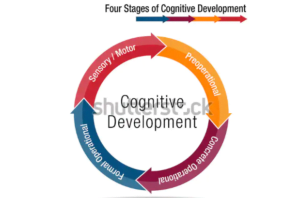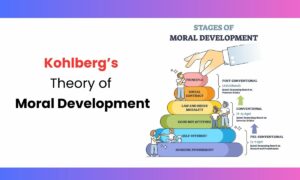If you are looking for a Complete Guide to Bloom’s Taxonomy with easy Explained for the students then you are here at the right place. This article will help you to learn about
- What is Bloom’ Taxonomy?
- Original and Revised Bloom’s Taxonomy
- Bloom’s Taxonomy Levels of Learning
- Bloom’s Taxonomy Verbs
- Bloom’s Taxonomy wheels
- Why it is Important?
- How to Use Bloom’s Taxonomy in Educational Objective
Bloom’s Taxonomy is an essential framework for educators to design the instructional objective and assessments that encourage to development of critical thinking and deeper learning among students.
The Bloom Taxonomy was introduced by the American Psychologist Benjamin Bloom in 1956. Since then Bloom of taxonomy is recognized as a useful tool to develop educational objective
What is Bloom’s Taxonomy?
Bloom’s taxonomy is a set of hierarchical models used to classify educational learning objectives into levels of complexity and specificity. Bloom’s taxonomies are classified into 3 domains and 6 different levels of cognitive skills arrange from lower-order thinking skills to higher-order thinking skills. The three major Bloom’s tax domains are Cognitive, Affective, and Sensory/Psychomotor.
Bloom’s Taxonomy Background Information:
- The taxonomy was proposed by Benjamin Bloom in 1956, He was an educational psychologist at the University of Chicago.
- The first volume of taxonomy, Handbook I: Cognitive was published in 1956
- The second volume of taxonomy, Handbook II: Affective was published in 1964.
- The framework was revised in 2001 and called revised Bloom’s taxonomy.
What are the three domains of Bloom’s Taxonomy?
The three domains of Bloom’s taxonomy is is again sub-categories into six different levels based on the thinking skills arrange from the lower-order thinking to higher-order thinking skills.
- The cognitive domain ( Knowledge-based)
- The Affective domain ( Emotion-based)
- The psychomotor domain ( Action based)
Bloom’s Taxonomy Domain
1. The cognitive domain:
Bloom’s Taxonomy of the cognitive domain includes the cognitive skills related to knowledge, Comprehension and problem-solving
In the original version of the taxonomy bloom, the cognitive domain is further divided into 6 levels. Revised edition of Bloom’s taxonomy In 2001, the levels are slightly different from the original taxonomy: Remember, Understand, Apply, Analyze, Evaluate, Create (rather than Synthesize). the name is changed from noun to verb form.
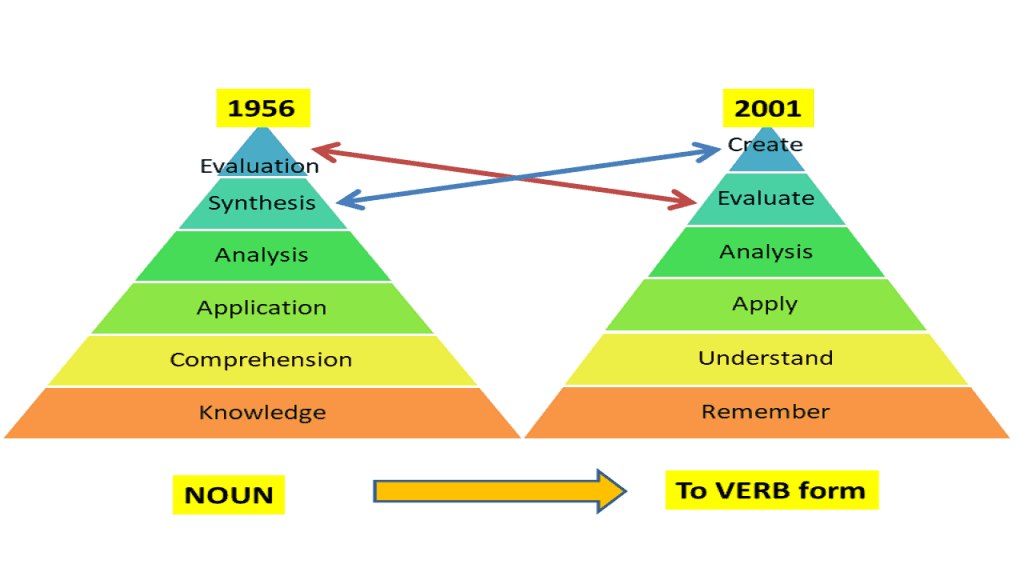
Original Bloom’s Taxonomy of Cognitive Domain ( 1956)
The cognitive domain of bloom taxonomies is further divided into six levels these are-
Level-1. Knowledge: It involves the recall of specifics and universals, the recall of methods and processes, or the recall of a pattern, structure, or setting.
Level-2. Comprehension: It refers to a type of understanding or apprehension such that the individual knows what is being communicated and can make use of the material or idea being communicated without necessarily relating it to other material or seeing its fullest implications.
Level-3. Application: It refers to the “use of abstractions in particular and concrete situations.”
Level-4. The analysis: represents the “breakdown of a communication into its constituent elements or parts such that the relative hierarchy of ideas is made clear and/or the relations between ideas expressed are made explicit.”
Level-5. Synthesis: It involves the “putting together of elements and parts so as to form a whole.”
Level-6. Evaluation: produces “judgments about the value of material and methods for given purposes.
Revised Bloom’s Taxonomy of the cognitive domain ( 2001)
Bloom’s original taxonomy was revised by his old students Loris W. Anderson and David R. Krathwohl in 2001. Let us discuss the six levels of the cognitive domain with Bloom’s taxonomy examples
Level-1: Remembering: This level of taxonomy of Bloom required students to bring, recognize, and recall relevant knowledge from long-term memory.
Example: Memorize a poem, recall the state names, and remember math’s formula.
Level-2. Understanding: This level involves Constructing the meaning of oral, written, and graphic messages through summarizing, interpreting, classifying, comparing, etc. information they have learned
Example: Organize an animal kingdom based on a given structure, and illustrate the difference between a square and a rectangle.
Level-3. Applying: This level required students to use the information they have to learn in a new or different way.
Example: Use a formula to solve a new problem
Level-4. Analyzing: Breaking materials or concepts into small parts, determining how one part relates to other parts or how the parts related to overall structure or purpose.
Example: Why are Dolphins called mammals, identify why the machine is not working.
Level 5. Evaluate: This level of students require to Make a judgment based on the value or quality of information
Example: Making a judgment regarding an ethical dilemma, interpreting the significance of the given law of physics.
Level 6. Create: This level required students to Positioning elements together to form a rational or functioning whole; recognizing elements into a new
Bloom’s Taxonomy Verbs
Bloom’s Taxonomy verbs are the key aspects to describe the level of cognitive skills. Each level of taxonomy is associated with action verbs that reflect the cognitive skills required at different levels.
| Bloom’s Taxonomy Level | Verb | Definition | Example |
| Remembering | Recall | Retrieving previously learned information | List, Name, and Identify |
| Define | Stating a precise meaning of a word or idea | Define, Describe, and Explain | |
| Understanding | Summarize | Restate in a concise form | Summarize, Paraphrase, Translate |
| Explain | Clarify meaning or reasoning | Explain, Discuss, Distinguish | |
| Applying | Apply | Use the information in a new way | Apply, Demonstrate, Illustrate |
| Solve | Using acquired knowledge to solve problems | Solve, Compute, and Demonstrate | |
| Analyzing | Analyze | Break down information into parts and examine relationships | Analyze, Compare, and Contrast |
| Categorize | Grouping items based on similar characteristics | Categorize, Classify, Organize | |
| Evaluating | Evaluate | Make judgments about information | Evaluate, Assess, and Critique |
| Justify | Supporting opinions with reasoning | Justify, Support, Argue | |
| Creating | Create | Generating new ideas, products, or solutions | Create, Design, and Construct |
| Invent | Original thinking to create something new | Invent, Imagine, Plan |
2. The Affective domain
Skills in the affective domain describe the way people react emotionally and their ability to feel other living things’ pain or joy. Affective objectives typically target the awareness and growth in attitudes, emotions, and feelings.
There are five levels in the affective domain moving through the lowest-order processes to the highest:
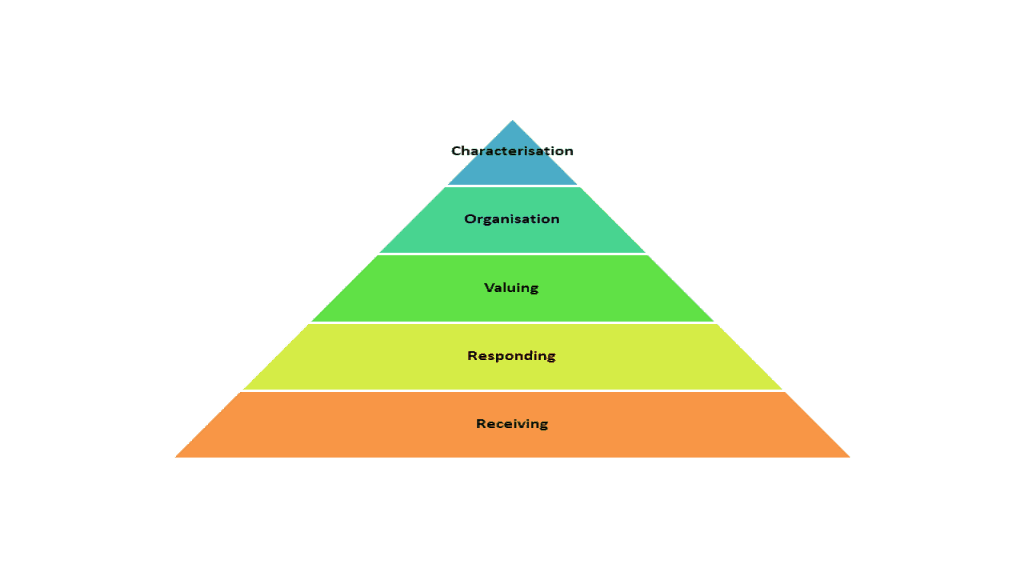
1. Receiving: The lowest level; the student passively pays attention. Without this level, no learning can occur. Receiving is about student memory and recognition as well.
- Attending the learning session
- Be aware of what knowledge is being imparted.
- Be willing to hear/ receive the knowledge that is being imparted
- Be attentive to listen to whatever knowledge is being imported.
Example: Listen to and be aware of the names of newly introduce participants.
2. Responding: The student actively participates in the learning process, not only attends to a stimulus; the student also reacts in some way
- Be willing
- react
- Be satisfied to respond ( be motivated to respond)
Example: Participating in a group discussion or giving a presentation.
3. Valuing: The student attaches a value to an object, phenomenon, or piece of information. The student associates a value or some values with the knowledge they acquired.
- Attach value to the phenomenon
- Strongly associated with the topic
- Demonstrate commitment to a certain value
Example: proposing a plan to bring about improvement on a social level.
4. Organisation: The student can put together different values, information, and ideas and accommodate them within his/her own schema: comparing, relating, and elaborating on what he has been learned
- Prioritize different values, and resolve conflicts.
- Emphasis prioritize other people
Example: Emphasis priorities on work-life balance at the workplace or freedom of speech with responsive behaviour.
5. Characterisation by value set: The student at this level tries to build abstract knowledge
- Completely internalize his/her values and behave in accordance
- Be predictable in his/her behaviour and in supporting these values
- Let his value system control behaviour.
Example: Displays consistently through commitment towards the ethical practice of the value system or Multilevel marketing business need employees to associate this level of emotion.
3. The Psychomotor domain
The psychomotor objective is specific to physical function, reflex actions, and body movements to interpret information and learn. It implies that physical activity supports or is a vehicle for cognitive growth and furthering knowledge or skills. The learner uses physical action to achieve a cognitive or affective objective.
It is further divided into 5 levels, these are:
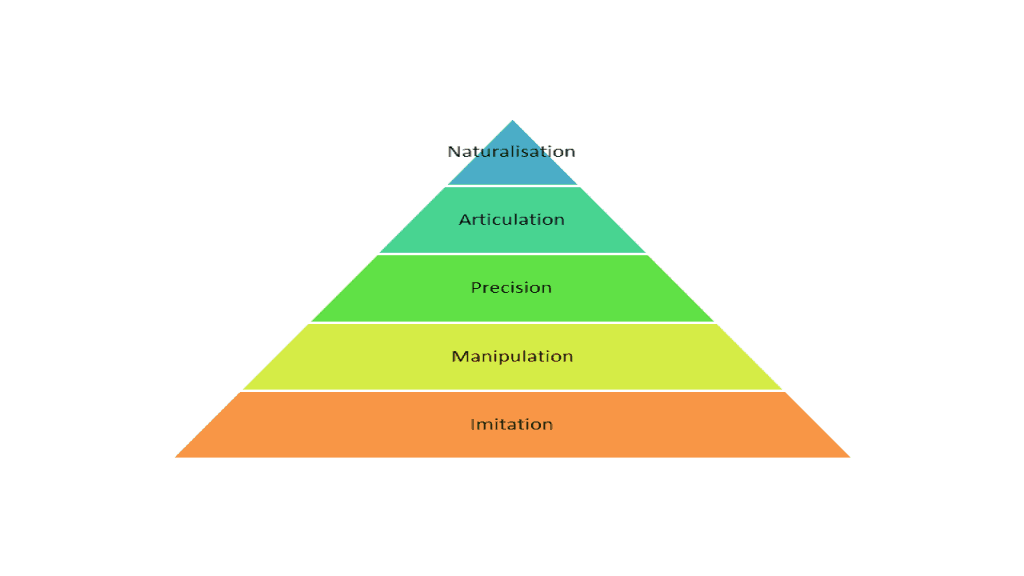
- Imitation: At this level, the learner will-
- Directly copy action seen
- Replicate what’s directly observed
- Example: Aling his/her own car seat exactly as advised by the driver’s instruction.
2. Manipulation: At this level, the learner will-
- Reproduce activity by instruction.
- Reproduce activity by memory
- Example: Look into the back and side mirror every time intend to take a turn
3. Precision: At this level, the learner will-
- Execute skill independent of help
- Example: Slow the car down in anticipation of a red light without being instructed.
4. Articulation: At this level, the learner will-
- Adapt expertise to complete a non-standard objective.
- Example: Stop behind a parked car to give away to an incoming vehicle without instruction.
5. Naturalisation: At this level, the learner will-
- Automate skills
- Unconscious mastery skills.
- Example: Pass a practical driving test by independently driving satisfactorily.
Why Use Bloom’s Taxonomy?
- Objectives (learning goals) are important to establish in a pedagogical interchange so that teachers and students alike understand the purpose of that interchange.
- Organizing objectives helps to clarify objectives for themselves and for students.
- Having an organized set of objectives helps teachers to:
- “plan and deliver appropriate instruction”;
- “design valid assessment tasks and strategies”; and
- “ensure that instruction and assessment are aligned with the objectives.”
Criticism of Bloom’s Taxonomy
1. Learning isn’t orderly sequential – Bloom’s Hierarchy seems too artificially constructed. It is a linear, straightforward view of how humans understand information. Although each concept or classification has its place, researchers are starting to see the mind as more of the internet.
A person might bounce from knowledge to application then analyze the application, come to a conclusion (evaluation) then re-analyze the conclusion all working toward a greater synthesis of information.
Constructivist teaching has suggested that teachers need to spread higher-order thinking skills throughout a task rather than begin with the imparting of only knowledge. The shortcoming of the taxonomy and the need for an appropriate structure to become learner-centred.
2. It is incomplete – Bloom concentrated his efforts only on learning, yet there is little about motivation or classroom management.
3. It is too fixed – Classifying and separating learning into three domains and good hierarchies is a very modern, scientific view of learning. Yet, a Criticism of postmodernism would attempt to deconstruct this idea.
For one, they might suggest that neuroscience remains in its earliest formation and we don’t entirely understand the mystery of the mind. In addition, postmodernists would suggest that a lot of the terms are simply artificial constructs used as an ideology to hide the messy side of learning
4. It is individualistic – Unlike the Social Learning Theory, Bloom’s Taxonomy emphasizes heavily how an individual learns. It misses the other way of learning like social interaction, group discussion, tours etc.
For example, an individual’s ability to reach “evaluation” can be easily through group discussion.
How to Apply Bloom’s Taxonomy in Your Classroom?
Bloom’s Taxonomy can be used in the classroom in various ways to help educators create effective lesson plans, assessments, and activities that foster higher-order thinking skills among students. By incorporating Bloom’s Taxonomy into the classroom, teachers can create a more engaging and effective learning environment that promotes higher-order thinking skills among students. Here are some ways it can be applied:
- Curriculum Design: Bloom Taxonomy is very useful for the teacher to design an effective curriculum that covers all the six levels of cognitive processing and they can ensure that students learn and master various skills and knowledge.
- Lesson Planning: Bloom’s taxonomy is very useful for a teacher to design an effective lesson plan by first identifying the educational objective for each lesson and selecting the instructional strategies, materials, and assessments that align with the objective
- Assessment Development: Bloom Taxonomy can be used to design assessments that evaluate students’ understanding, application, analysis, evaluation, and creative skills. This ensures that assessments go beyond simple recall of information and evaluate students’ ability to apply the learned information in complex and meaningful ways.
- Questioning Techniques: Teachers can use Bloom’s Taxonomy to develop questioning techniques that engage students in higher-order thinking. By asking open-ended questions that require students to analyze, evaluate, and create, teachers can challenge students to think more deeply about the topic at hand.
- Differentiated Instruction: Teachers can use Bloom Taxonomies to differentiate their instruction to meet the needs of diverse learners. By varying the complexity of the tasks and activities based on the student’s abilities, teachers can ensure that all students are challenged and engaged in the learning process.
Bloom’s Taxonomy Wheel
The Bloom Taxonomy Wheel is a visual representation of Bloom’s Taxonomy that resembles a wheel, with the six levels of the taxonomy arranged in a circular pattern. It provides a visual aid for educators to create lesson plans and assessments that promote different levels of cognitive complexity, starting from the lower-order thinking skills at the bottom of the wheel and progressing to higher-order thinking skills at the top. A wheel is a useful tool for educators to promote student engagement and learning through different levels of thinking
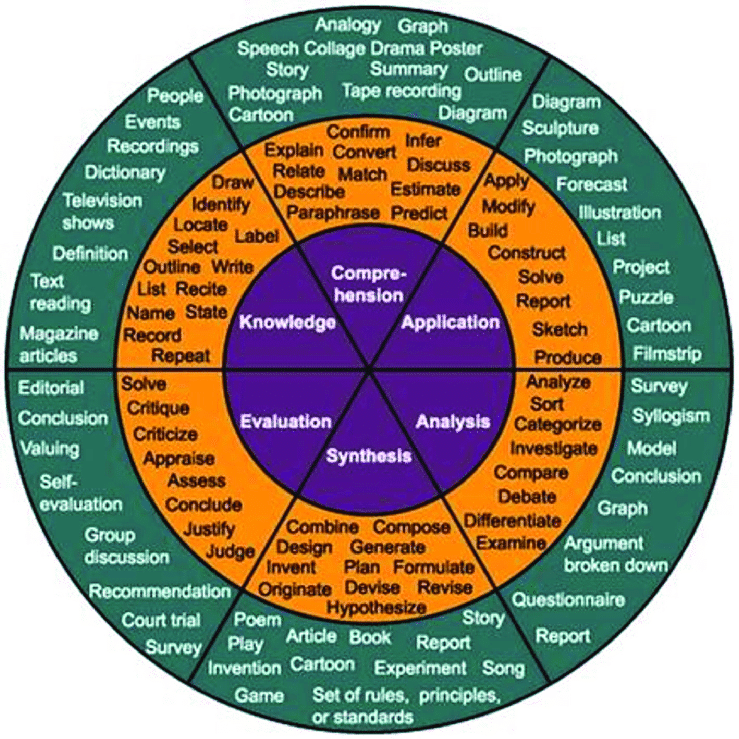
In conclusion, Bloom’s Taxonomy provides a framework for educators to design instruction and assessments that promote higher-order thinking skills among students. By focusing on educational objectives and using Bloom’s Taxonomy notes as a guide, teachers can explain the taxonomy to students in a way that is accessible and meaningful. Overall, Bloom’s Taxonomy is an essential tool for creating effective and engaging learning experiences for students.
References:
- Wengroff, J. (2020). What is Bloom’s Taxonomy? – Synapse. [online] Synapse. Available at: https://getsynapse.com/blog/what-is-blooms-taxonomy/ [Accessed 23 Jan. 2020].
- Part II: Chapter 4: Analyzing Quantitative Data. (2020). Retrieved 28 January 2020, from https://www.nsf.gov/pubs/1997/nsf97153/chap_4.htm.
Frequently Asked Questions (FAQs)
What are the three-domain of Bloom’s Taxonomy?
There is 3 domain of Bloom’s Taxonomy Cognitive domain, the Affective domain, and the psychomotor domain.
What are the 6 levels of Bloom’s Taxonomy?
There are 6 levels of Bloom’s taxonomy in the cognitive domain are
1. Knowledge
2. Comprehension
3. Application
4. Analysis
5. Synthesis
6. Evaluation
What are the 6 levels in reverse Bloom’s Taxonomy?
Bloom’s original taxonomy was revised by his old students Loris W. Anderson and David R. Krathwohl in 2001. It is divided into six levels these are-
1. Remember
2. Understand
3. Apply
4. Analyze
5. Evaluate
6. Create
How do you explain Bloom’s taxonomy to children?
Bloom’s Taxonomy can be explained to children as a tool that helps them learn and grow by asking questions and solving problems. It has six levels of thinking skills, from basic recall to complex problem-solving, and encourages them to use their minds to their fullest potential.
How to use Bloom’s taxonomy in the classroom?
Bloom’s Taxonomy can be used in the classroom to design instruction and assessments that promote higher-order thinking skills. Teachers can use the taxonomy to set learning objectives, create lesson plans, develop assessments, and differentiate instruction to meet the needs of all students

